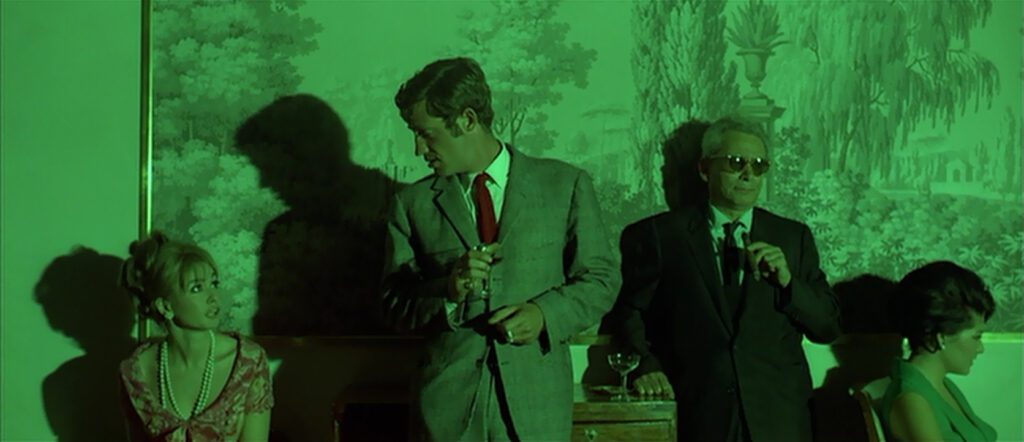
Pierrot le fou
1965, directed by Jean-Luc Godard
The name “Pierrot” comes from a famous stock character of Italian commedia dell’arte, a sad clown who usually falls in love with the maid Columbine. Jean-Paul Belmondo’s character, who bears this nickname in Pierrot le fou, is, true to the name’s roots, a personification of art. He’s introduced buying a book on art history from which he reads a passage about Velazquez in the opening shots. Throughout the film he will continually drop names from literature, painting, music, and cinema. He’s out of work, recently fired from a television station, and when his wife pressures him to join the corporate world he runs off with his ex-girlfriend Marianne, whose name is an easily recognizable symbol of France. She dresses in the colors of the French flag; at one point she’s framed in front of the flag for almost three minutes; and her on-and-off relationship to Pierrot is like France’s long, intense, and complicated relationship to art.
Pierrot’s journey with Marianne is punctuated by frequent excerpts from his journal. His last entry, right before he dynamites himself on a Côte d’Azur island, is extremely short. It says “la rt” (an odd formatting of “l’art”) until Pierrot’s pen crowds in two additional letters to form “la mort”– i.e. death. On one hand this simply reinforces Pierrot’s identity as an embodiment of art; he is art, and he is about to die. His end is foretold much earlier, at the party where Sam Fuller defines cinema in five emotional words, the last one being “death”. On the other hand, given the allegorical standing of the two lead characters, the diary entry begs to be read in a larger context.
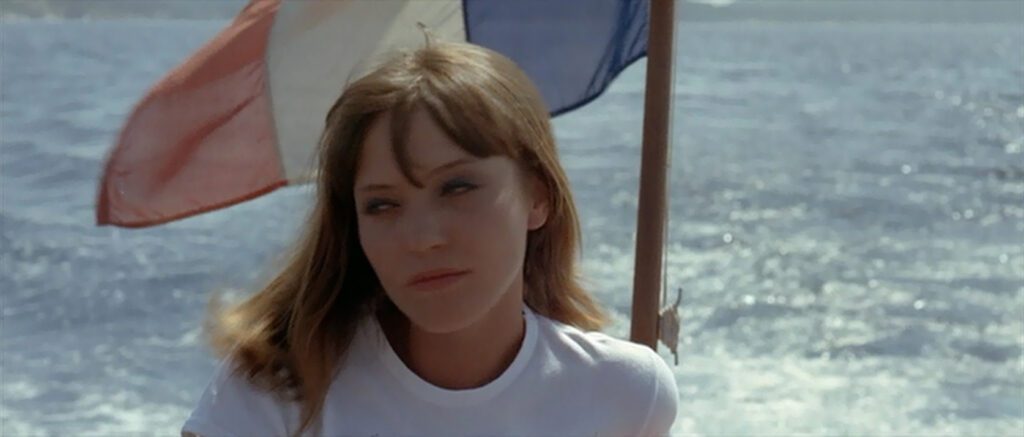
The easy interpretation would be to read Pierrot’s death as the end of art, a dire prognosis for the modern world akin to the “fin de cinéma” at the end of Weekend. It would be an understandable conclusion after watching partygoers talk like figures from deodorant commercials, or seeing the character who represents France, who’s supposed to be in love with art, reading a comic book and cheating on Pierrot with gangsters and gun runners (as France was recently preoccupied with armed conflicts in Indochina and Algeria). But however warranted such pessimism may be, there’s a more constructive way to look at Pierrot’s death and his final journal entry… a counterintuitive interpretation consistent with Godard’s adjacent films, but to see it we must prepare ourselves to embrace a sacrilege.
What if the movie means to equate art with death? This would surely be too much to swallow, especially for people interested in “art films” like Pierrot le fou. But let us consider how much we stand to gain by throwing out the lofty notion of art. Godard’s war is not with the works we usually call “art”, but rather with the idea itself. Certainly there are good paintings, music, movies, novels, plays, poems, and so on, but what extra quality does the label “art” add to their value? The plural form is benign, “the arts” being the category of all creative works, but the singular “art” often means to convey something intangible, a quasi-religious value that cannot be defined.
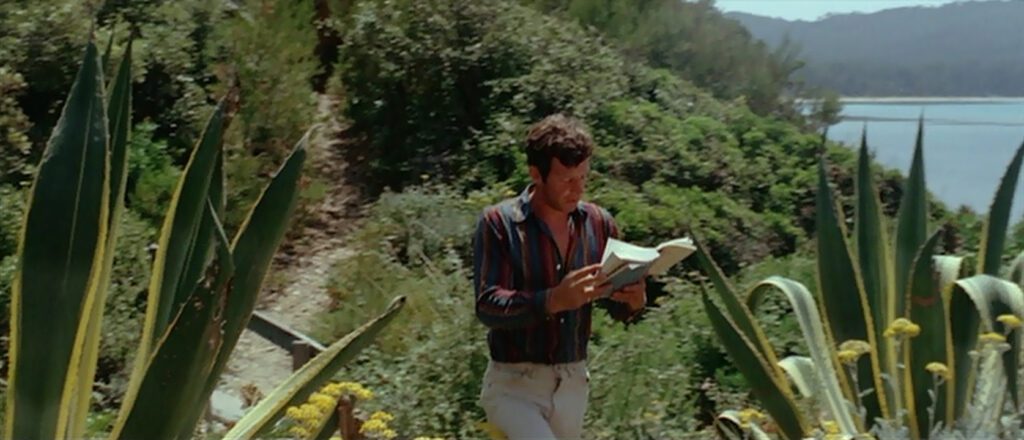
We first see Pierrot at a Parisian book shop called “Le meilleur des mondes” (The Best of Worlds). The store’s name expresses the same idealism that’s intrinsic to the concept of art. It’s not that great sculpture, poetry, etc. are utopian in themselves – they often depict anguish and violence – it’s that people so often imbue them with an imaginary perfection that fails to pay respect to their actual virtues. In the opening shots Pierrot reads from the volume of art history he finds at this bookstore:
“Velazquez past the age of 50 no longer painted specific objects. He drifted around things like the air, like twilight, catching unawares in the shimmering shadows the nuances of color that he transformed into the invisible core of his silent symphony. Henceforth he captured only those mysterious interpenetrations that united shape & tone by means of a secret and unceasing progression….”
Here we have a concrete example of the kind of breathless abstraction critics fall into when they embrace the idea of capital-A Art. Instead of speaking in clear language about Velazquez’ purpose and technique, the writer tries to compete with the painter through a kind of empty poetics. And in case this passage needs deflating, we are shown Pierrot reading its continuation to his daughter in a bathroom. If it’s so absurd to think the words would mean anything to a little girl, we might ask ourselves whether they make any sense to us either.
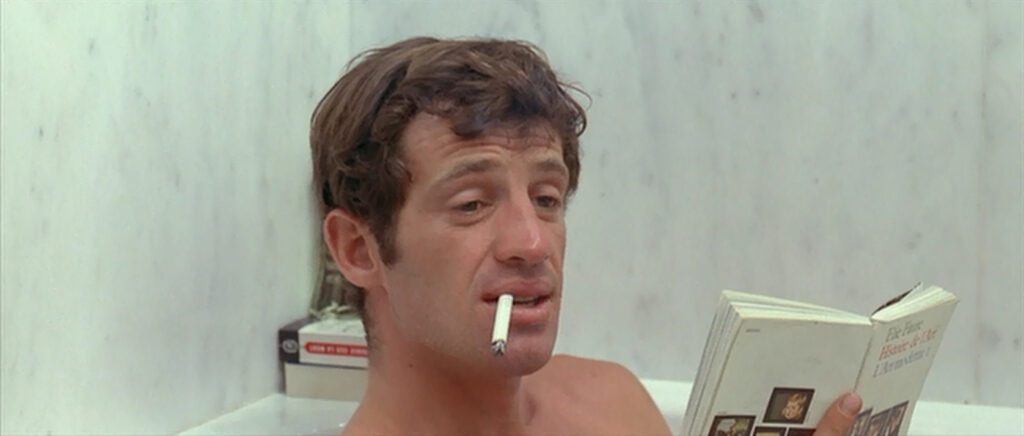
Godard’s last movie before Pierrot le fou was Alphaville, which attacks the simple-mindedness of the Cold War mentality by calling attention to reductive uses of language, particularly opposites, which lead humans to think in binary terms like computers. In Pierrot he continues the war against abstraction on another front, attacking an idea of art that simultaneously elevates its subject, putting creative works on a pedestal, and diminishes it, treating artworks with a reverence that forbids any consideration of their practical value, e.g. in changing the ways people look at their world.
While the argument in Pierrot le fou extends to all the arts, Godard is a film critic by vocation, and he makes a particular example of cinema. Early in the film Pierrot attends an upper class house party where he asks American movie director Samuel Fuller what exactly cinema is. Fuller replies, “A film is like a battleground. Love, Hate, Action, Violence, Death. In one word, emotions.” If we paid attention to what the movie did with the critique of Velazquez, we ought at least to be suspicious of this definition of cinema. It too sounds abstract and slippery, a meaningless statement that would allow us to make whatever we want of cinema.

Instead of directly refuting or contesting Fuller’s definition, Pierrot le fou embraces it and runs with it. After the house party we get scenes of love (Pierrot’s reunion with Marianne), hatred (confronting Marianne’s boyfriend and stealing her away), action (assaulting the petrol station crew and running off without paying), and violence (blowing up the car with a rifle shot to the gas tank). The entire road trip to the Mediterranean is a mish-mash of Fuller’s elements of cinema – ending, of course, like Fuller does, with death. Having conditionally accepted Fuller’s definition, Pierrot le fou shows how weak a framework it is for making a movie. Just as the party scene lampoons bourgeois life with conversations that sound like advertising patter, the road trip lampoons the shallowness of movies that depend on triggered emotions – which would include numerous films that Nouvelle Vague directors had elevated to the status of art in Cahiers du cinéma.
Far from sparing himself, Godard points his sharpest criticism at his own first feature, Breathless. Like Breathless, Pierrot le fou stars Jean-Paul Belmondo as a fugitive in a whirlwind romance that ends in betrayal and death. In the movie theater scene there’s an insert of his Breathless co-star Jean Seberg. Pierrot resumes his relationship with Marianne after a 5½ year separation, the exact amount of time between the releases of both movies. As early as December 1962 Godard had said that when he made Breathless he thought it was Scarface but that it belongs instead alongside Alice in Wonderland. In other words, while trying to create art he ended up making something juvenile. There’s a particular danger when artists themselves set out consciously to create art; if that’s the intention the result will likely be stillborn.
Whether Godard realized it or not, the title of Breathless is a totally fitting description for the unabashed veneration people display in the face of whatever they choose to call “art”. This breathless attitude to art goes hand in hand with a radical subjectivity that turns the arts, especially cinema, into an entirely private experience, absolving the critic or viewer from understanding the work on its own terms and denying it its own voice. Before Pierrot departs for the final scene on the island, he meets a strange man on the quay who personifies this popular view. The poor man hears a recurring melody that reminds him of his entire history of love affairs, and in his madness he expects everyone else to hear it floating in the air as he does. When Pierrot denies hearing the melody, the man calls him “insensitive” and says “You missed the whole point!” The episode is almost laughable, except it’s much too true to life. It’s all too common for people to value artworks for the ways they cathect to their own private experiences, like the man on the quay remembering his first love.
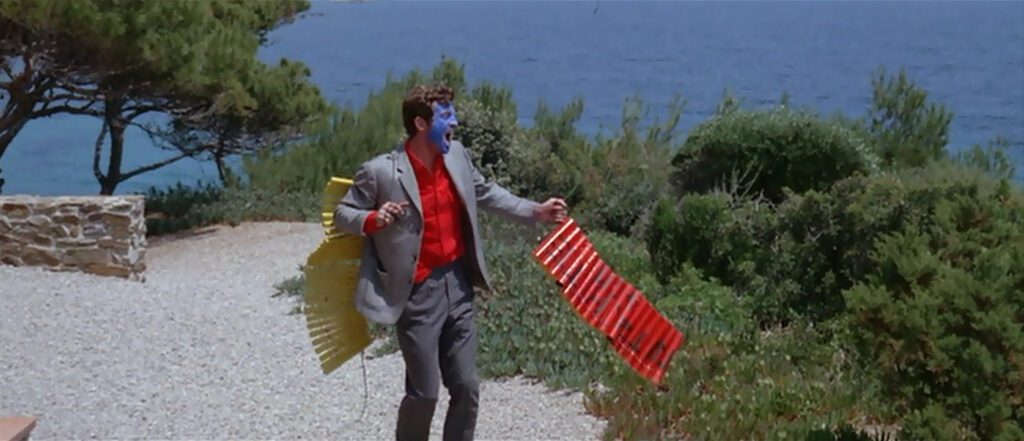
Before Pierrot blows himself up he paints his face blue and wraps his head in yellow and red strings of dynamite. The three layered primary colors are a shorthand for art, the minimum pigments needed to represent the world on canvas. The movie argues that the concept of art is a dead end, a false abstraction that gives license to an imaginary, solipsistic, and lifeless expectation of human creativity. By glamorizing the artwork itself, the word “art” evokes a false sense of wonder that should properly be reserved for the insight or subject that the artwork expresses.
Pierrot le fou closes with a pan over the open Mediterranean, while a voice whispers that it’s “just the sea and the sun.” It’s a fitting end to an argument that wishes to do away with the word “art”. The same idea runs through Antonioni’s movies, particularly L’eclisse – only when we try to look at things in themselves, whether from nature, the objects of ordinary life, or the subject of any movie, painting, or poem, can we begin to develop a genuine sense of appreciation.
CONNECTIONS:
Vampyr – Link between art and death
Les visiteurs du soir – Marianne figure as a symbol of France
Orphée – Art as an expression of a death wish
Breathless – Belmondo as fugitive lover; Jean Seberg; betrayal & death; 5½ year separation
L’eclisse – Idea that wonder comes from seeing things as they are, not as we wish them to be
Vivre sa vie – Critique of “art” as an object of misplaced reverence
Alphaville – Critique of Breathless; Ford Galaxy; nighttime drive with Anna Karina; war on abstraction
Persona – Argument about a definition of cinema
Roselyne and the Lions – Skepticism toward art; viewer’s disappointment enlisted to make a point
The Truman Show – Characters talking like a TV commercial; breaking fourth wall